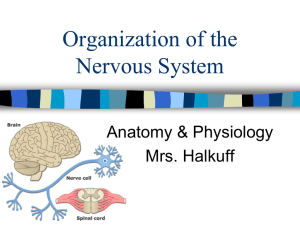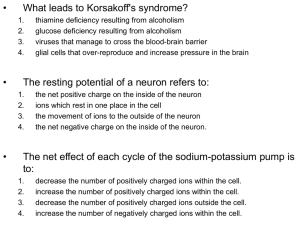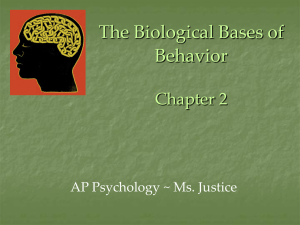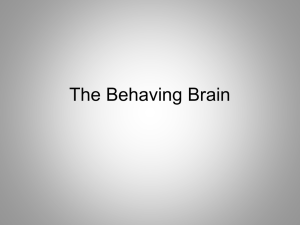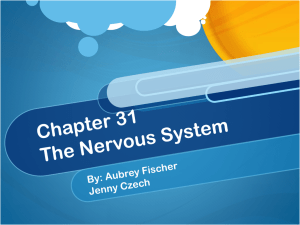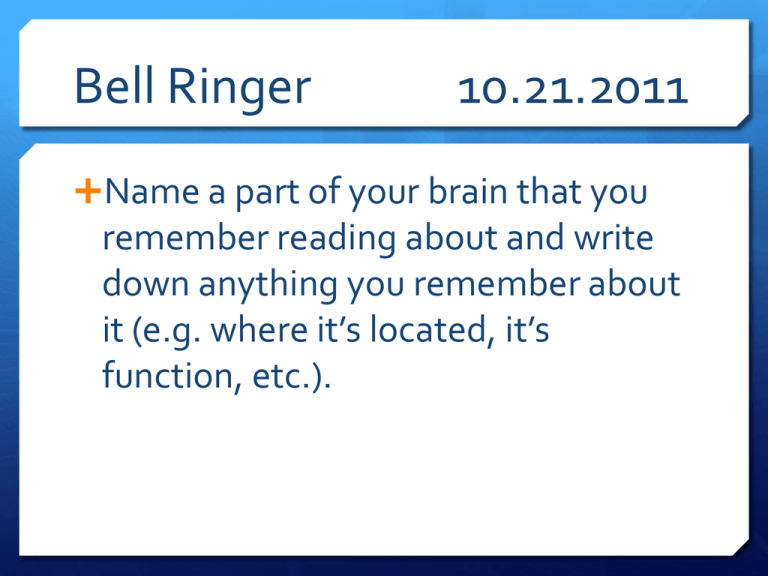
Bell Ringer
10.21.2011
Name a part of your brain that you
remember reading about and write
down anything you remember about
it (e.g. where it’s located, it’s
function, etc.).
Unit 3: Biological Bases of
Behavior
AP Psychology
Ms. Desgrosellier
Neuropsychologists:
psychologists who explore the
relationships between brain/nervous
systems and behavior.
aka: biological psychologists,
biopsychologists, behavioral geneticists,
physiological psychologists, and
behavioral neuroscientists.
ORGANIZATION OF YOUR
NERVOUS SYSTEM
All of the neurons in your body are organized
into your nervous system.
The two major subdivisions are the central
nervous system and the peripheral nervous
system.
ORGANIZATION OF YOUR
NERVOUS SYSTEM
Central Nervous System (CNS): made up of
the brain and spinal cord.
Spinal cord: starts at the base of your back
and extends upward to the base of your skull
where it joins your brains.
Made mainly of interneuron’s and glial cells,
which are all bathed by cerebrospinal fluid
produced by your glial cells.
ORGANIZATION OF YOUR
NERVOUS SYSTEM
Peripheral Nervous System (PNS): made up the
somatic and autonomic nervous systems, and
spread around your body from your spinal cord
outwards.
Somatic Nervous System: motor neurons that
stimulate skeletal (voluntary) muscle.
Autonomic Nervous System: motor neurons
that stimulate smooth (involuntary) and heart
muscle.
ORGANIZATION OF YOUR
NERVOUS SYSTEM
The Autonomic Nervous System is divided into two
parts:
Sympathetic Nervous System: Responses that help
your body deal with stressful events, including:
Dilation of pupils, release of glucose from your liver,
dilation of bronchi, inhibition of digestive functions,
acceleration of heart rate, secretion of adrenalin from
your adrenal glands, acceleration of breathing rate,
and inhibition of secretion of your tear glands.
ORGANIZATION OF YOUR
NERVOUS SYSTEM
The Autonomic Nervous System is divided
into two parts:
Parasympathetic Nervous System: Calms
your body following sympathetic stimulation
by restoring digestive processes (salivation,
peristalsis, enzyme secretion), returning
pupils to normal size, stimulating tear glands,
restoring normal bladder contractions, slow
breathing and heart rate, etc.
ORGANIZATION OF YOUR
NERVOUS SYSTEM
Turn to your neighbor and explain the two
major subdivisions of the nervous system.
What are the 2 parts of the CNS?
What are the 2 parts of the PNS?
What are the 2 parts of the autonomic NS?
Nervous System
Peripheral Nervous
System
Central Nervous
System
Brain
Autonomic
Nervous System
Sympathetic
Nervous System
Spinal
Cord
Somatic Nervous
System
Parasympathetic
Nervous System
STRUCTURE AND FUNCTION OF THE
NEURON
neuron: the basic unit of structure and
function of your nervous system.
three major functions:
receive information, process it, and
transmit it to the rest of your body.
STRUCTURE AND FUNCTION OF THE
NEURON
glial cells: guide the growth of
developing neurons, help provide
nutrition for and get rid of wastes of the
neuron, and form an insulating sheath
around neurons that speeds conduction.
STRUCTURE AND FUNCTION OF THE
NEURON
cell body (cyton or soma): contains
cytoplasm and the nucleus, which directs
synthesis of neurotransmitters.
STRUCTURE AND FUNCTION OF THE
NEURON
CELL BODY
STRUCTURE AND FUNCTION OF THE
NEURON
dendrites: branching tubular processes
capable of receiving information.
axon: emerges from the cyton as a
single conducting fiber (longer than a
dendrite) which branches.
STRUCTURE AND FUNCTION OF THE
NEURON
DENDRITES
CELL BODY
AXON
STRUCTURE AND FUNCTION OF THE
NEURON
terminal button (axon terminal or
synaptic knob): tip of the axon.
myelin sheath: fatty tissue created by
glial cells that insulate the axon and
speeds up transmission.
STRUCTURE AND FUNCTION OF THE
NEURON
DENDRITES
AXON TERMINAL
AXON
MYELIN
SHEATH
CELL BODY
STRUCTURE AND FUNCTION OF THE
NEURON
nucleus: holds all the genetic
information of the cell.
node of Ranvier: gaps between the
myelin sheaths.
Schwann’s cells: cells that create
myelin.
STRUCTURE AND FUNCTION OF THE
NEURON
DENDRITES
AXON TERMINAL
SCHWANN’S CELLS
NODE OF RANVIER
AXON
MYELIN
SHEATH
NUCLEUS
CELL BODY
STRUCTURE AND FUNCTION OF THE
NEURON
neurogenesis: growth of new neurons
that takes place throughout life.
Bell Ringer
10.24.2011
Sketch out the nervous system “tree”
and briefly explain each section.
HAVE YOUR NEURON
HOMEWORK OUT TO BE
CHECKED.
Nervous System
Peripheral Nervous
System
Central Nervous
System
Brain
Autonomic
Nervous System
Sympathetic
Nervous System
Spinal
Cord
Somatic Nervous
System
Parasympathetic
Nervous System
STRUCTURE AND FUNCTION OF THE
NEURON
DENDRITES
AXON TERMINAL
SCHWANN’S CELLS
NODE OF RANVIER
AXON
MYELIN
SHEATH
NUCLEUS
CELL BODY
STRUCTURE AND FUNCTION OF THE
NEURON
neurotransmitters: chemicals stored in
structures of the terminal buttons called
synaptic vesicles.
Used by neurons to communicate with
each other.
STRUCTURE AND FUNCTION OF THE
NEURON
Synapse: the gap between neurons where
neurotransmitters are released to attach to
specific receptor sites on membranes of
dendrites of your postsynaptic neurons.
This is called the “lock and key concept”
because each neurotransmitter has a
specific match on the dendrites, like a key
fitting into a lock.
STRUCTURE AND FUNCTION OF THE
NEURON
STRUCTURE AND FUNCTION OF THE
NEURON
IN YOUR NOTES, create a 4 column
table to fill out (we will add rows
together)
Neurotransmitter
Function
Too Much:
Too little:
NEUROTRANSMITTERS
e.g. acetylcholine (ACh) causes
contraction of skeletal muscles, helps
regulate heart muscles, is involved in
memory, and also transmits messages
between the brain and spinal cord.
Lack of ACh is associated with
Alzheimer’s disease.
NEUROTRANSMITTERS
Neurotransmitter
Function
Too Much:
acetylcholine muscle
n/a
movement
(ACh)
, memory,
messages
between
brain &
spinal cord
Too little:
Alzheimer’s
disease
NEUROTRANSMITTERS
dopamine: stimulates the
hypothalamus to synthesize hormones
and affects alertness and movement.
Lack of dopamine is associated with
Parkinson’s disease.
Too much is associated with
schizophrenia.
NEUROTRANSMITTERS
glutamate: excitatory neurotransmitter
involved in information processing
throughout the cortex and especially
memory formation in the hippocampus.
Both schizophrenia and Alzheimer’s may
involve glutamate receptors.
NEUROTRANSMITTERS
Serotonin: associated with sexual
activity, concentration and attention,
moods, and emotions.
Lack of serotonin is associated with
depression.
NEUROTRANSMITTERS
endorphins:
opioid peptide,
considered the
brain’s own pain
killers.
NEUROTRANSMITTERS
Gamma-aminobutyric acid (GABA): inhibits
the firing of neurons.
Valium and anticonvulsant drugs increase
activity of GABA.
Huntington’s disease is associated with
insufficient GABA-producing neurons in parts
of the brain involved in the coordination of
movement.
Seizures are associated with malfunctioning
GABA systems.
NEUROTRANSMITTERS
Other chemicals, like drugs, can interfere
with the action of neurotransmitters.
Agonists may mimic a neurotransmitter and
bind to its receptor site to produce the effect
of the neurotransmitter.
Antagonists: block a receptor site inhibiting
the effect of the neurotransmitter or
agonist.
Neuron Functions
All behavior begins with the actions of your
neurons.
A neuron gets incoming information from its
receptors spread around its dendrites.
The info is then sent to the cell body, where
it’s combined with other incoming
information.
Neural impulses are electrical in nature along
the neuron.
Neuron Functions
The neuron at rest is more negative inside the
cell membrane relative to outside the
membrane.
The neuron’s resting potential results from
the selective permeability of its membrane
and the presence of electrically charged
particles called ions near the inside and
outside surfaces of the membrane in different
concentrations.
Bell Ringer
10.25.2011
Choose two neurotransmitters and
briefly describe them (include their
function, and what happens if there’s
too much or too little of it).
Neuron Functions
When sufficiently
stimulated (to
threshold), a net
flow of sodium ions
into the cell causes a
rapid change in
potential across the
membrane, known
as action potential.
Neuron Functions
If your stimulation is not strong enough,
your neuron does not fire.
The strength of the action potential is
constant whenever it occurs.
This is called the “all-or-none principle.”
Neuron Functions
The wave of depoloarization and
repolarization is passed along the axon to
the terminal buttons, which release
neurotransmitters.
Spaces between segments of myelin are
called nodes of Ranvier.
Saltatory conduction: When the axon is
myelinated, conduction speed is increased
since depolarizations jump from node to
node.
Neuron Functions
Neurotransmitters are released into the
synapse.
Some synapses are excitatory, meaning the
neurotransmitters cause the neuron on the
other side to generate an action potential (to
fire).
Other synapses are inhibitory, reducing or
preventing neural impulses.
Neuron Functions
The sum of all excitatory and inhibitory inputs
determines whether your next neuron will fire
and at what rate.
The constant flow of neurotransmitters
regulates metabolism, temperature, and
respiration.
It also enables you to learn, remember, and
decide.
Neuron Functions
reflex: simplest form of behavior, involving
impulse conduction over a few neurons.
The path across maybe three neurons is
called a reflex arc.
Afferent neurons: sensory neurons that
transmit impulses from your sensory receptors
to the spinal cord or brain.
Interneurons: located entirely in your brain
and spinal cord, intervene between sensory and
motor neurons.
Neuron Functions
Efferent neurons: motor neurons transmit
impulses form your sensory or interneurons
to muscle cells that contract or gland cells
that secrete.
Effectors: muscle and gland cells.
Neuron Functions
Examples of reflexes:
pupillary, knee jerk, sneezing, and blinking.
Neural impulses:
dendritesto cell bodies axons terminal
buttonsneurotransmitters synapse
among neurons from the receptor to the
effector.
TECHNIQUES TO LEARN ABOUT
STRUCTURE & FUNCTION
Clinical Observation (Case Study)
Look at injuries, diseases, etc.
TECHNIQUES TO LEARN ABOUT
STRUCTURE & FUNCTION
Over 150 years ago people were studying
patients with brain damage and linked
loss of structure with loss of function.
Essentially losing brain tissue caused
brain damage.
TECHNIQUES TO LEARN ABOUT
STRUCTURE & FUNCTION
Phineas Gage was a level-headed, calm foreman of
a railroad crew in 1848.
An explosion shot an iron rod through his head,
severing the connections between his limbic
system and his frontal cortex.
Gage became hostile, impulsive, and unable to
control his emotions or his obscene language.
Autopsy revealed that the relationship between
frontal lobes and control of emotional behavior.
Who is Phineas Gage?
Broca’s area
Paul Broca (1861) did an autopsy on a patient
named Tan, who couldn’t speak even though
there was no physical damage and he could
understand language.
Tan’s brain showed loss of tissue in part of the
frontal lobe of the left central cerebral
hemisphere (as did several other similar cases).
Broca’s area
It was concluded
that damage to this
so-called Broca’s
area caused a loss of
ability to speak,
known as expressive
aphasia.
Wernicke’s area
Carl Wernicke found
another brain area
involved with
understanding
language in the left
temporal lobe.
Destruction of
Wernicke’s area results
in loss of ability to
comprehend written
and spoken language,
known as receptive
aphasia.
DO NOW:
Briefly explain who Phineas Gage
was and why he is important to
Psychology.
Lesions
Precise destruction of brain tissue.
Enabled more systematic study of the loss of
function resulting from surgical removal,
cutting of neural connections, or destruction by
chemical applications.
Lesions
E.g. Surgery to relieve epilepsy cuts neural
connections at the corpus callosum, between
cerebral hemispheres.
Studies of patients with “split brains” have
shown that the left and right hemispheres do
not perform exactly the same functions.
Bell Ringer
10.26.2011
In your own words, briefly explain
how an action potential happens and
how a message is passed along a
neuron.
Right hemisphere:
nonverbal
spatial, musical, and holistic functions
identifying faces
recognizing emotional facial expressions
Left hemisphere:
verbal functions
mathematical functions
analytical functions
language
Manipulating the brain
Scientists can electrically, chemically, or
magnetically stimulate various parts of
the brain and note effects.
Researchers have electrically stimulated
different cortical areas of the brain during
surgery.
Manipulating the brain
It has enabled scientists to observe
results, like:
the frontal cortex at particular sites caused
body movement for different body parts
enabling mapping of the motor cortex.
New research has found that you can
magnetically lesion parts of the brain
(temporary and so far has shown no harm)
DO NOW
Tell me at least three functions of the
left hemisphere and three functions
of the right hemisphere of the brain.
Brain Imaging
Computerized axial
tomography (CAT or
CT): two-dimensional
x-ray slices that are
passed through various
angles of the brain,
arranged to show the
extent of a lesion.
Brain Imaging
magnetic resonance
imaging (MRI): a
technique that uses
magnetic fields and radio
waves to produce
computer-generated
images that distinguish
among different types of
soft tissue; allows us to
see structures within the
brain.
Brain Imaging
Putting one’s head into a
strong magnetic field
aligns the spinning atoms.
A pulse of a radio wave
disorients the atoms
briefly.
When the atoms return to
their normal spin, they
release signals that give us
a detailed image of the
body.
Measuring brain function
Scientists can stick a
tiny microelectrode
into a single neuron
to measure its
activity.
Measuring brain function
electroencephalogram
(EEG): an amplified
recording of the waves
of electrical activity
that sweep across the
brain’s surface. These
waves are measured by
electrodes placed on
the scalp.
Measuring brain function
The amplified tracings are
called evoked potentials
when the recorded changes
in voltage results from a
response to a specific
stimulus presented to the
subject.
Repeated study of the read-
out can help researchers
filter out brain activity and
find the electrical wave
caused by the specific
stimulus.
Measuring brain function
functional magnetic
resonance imaging
(fMRI): a technique for
revealing blood flow and,
therefore, brain activity
by comparing successive
MRI scans. MRI scans
show brain anatomy;
fMRI scans show brain
functions.
Measuring brain function
Researchers compare
images taken less than
a second apart, they
can see which parts of
the brain “light up”
with increased blood
flow.
Measuring brain function
positron emission
tomography (PET)
scan: a visual display of
brain activity that
detects where a
radioactive form of
glucose goes while the
brain performs a given
task.
Measuring brain function
Active neurons hog the
glucose (the brain’s
chemical fuel), and the
PET scan tracks where
in the brain the
radioactive glucose
goes.
Measuring brain function
Researchers can have participants think about
certain topics or do activities to see where the
glucose goes (thereby showing what part of
the brain is active during that activity).
The Brain
Covered by protective tissue called meninges
and housed in your skull.
The evolutionary perspective studies how the
human brain has evolved. One theory breaks
the brain into three sections:
The reptilian brain is similar to the brainstem
in humans, and is responsible for maintaining
homeostasis and instinctive behavior.
The Brain
The old mammalian brain roughly
corresponds to the limbic system that
controls emotional behavior, memory, and
vision.
The new mammalian brain or cerebral cortex,
accounts for 80% of the brain’s volume and is
associated with higher functions of judgment,
decision-making, abstract thought, foresight,
hindsight, and insight.
The Brain
The surface of the
cortex has peaks
(gyri) and valleys
(sulci), which form
convolutions that
increase the surface
area of your cortex.
Deeper valleys are
called fissures.
The Brain
The last evolutionary
development of the
brain is localization
of functions on
different sides of
your brain.
LOCALIZATION AND LATERALIZATION
OF THE BRAIN’S FUNCTION
Association areas: regions of the cerebral
cortex that do not have specific sensory or
motor functions, but are involved in higher
mental functions, such as thinking, planning,
remembering, and communicating.
LOCALIZATION AND LATERLIZATION
OF THE BRAIN’S FUNCTION
Contralaterality: control of one side of your
body by the opposite side of your brain.
The left side of your brain controls the right
side of your body.
The right side of your brain controls the left
side of your body.
Bell Ringer
10.27.2011
In your own words, briefly describe
the different functions of each
hemisphere of the brain.
Structure of Brain:
Brainstem
medulla: where most
fibers cross above the brain
stem, resulting in
contralateral (opposite
side) control.
regulates heart rate, blood
flow, breathing, digestion,
vomiting.
Structure of Brain: Brainstem
pons: right above the
medulla, helps
coordinate
movement, and is
the bridge between
cerebral hemispheres
and both medulla
and cerebellum.
Structure of Brain: Brainstem
reticular formation:
a nerve network in
the brainstem (pons)
that plays an
important role in
controlling arousal.
Structure of Brain
cerebellum:
coordinates motor
function integrating
motion and
positional
information from the
inner ear and
muscles.
helps maintain
balance.
Structure of Brain
basal ganglia (basal nuclei): links
the thalamus with the motor
cortex and other motor areas.
regulates initiation of movements,
balance, eye movements, and
posture.
Involved in reward/punishment
learning and focus.
Some nuclei (neural clusters)
involved in emotion.
Structure of Brain
thalamus: relay “station”
for sensory pathways
carrying visual, auditory,
taste, and somatosensory
information to/from
appropriate areas of
cerebral cortex.
Located at the top of the
brain stem.
Structure of Brain
hypothalamus: controls
autonomic functions such
as body temperature and
heart rate via control of
sympathetic and
parasympathetic centers
in the medulla.
Sets appetite drives (e.g.
thirst, hunger, sexual
desire) and behavior.
Structure of Brain
hypothalamus:
Integrates with endocrine
system by secretion of
hormones that regulate
hormones from the
pituitary.
Helps determine
biological rhythms.
Structure of Brain
amygdala: influences
aggression and fear.
Coordinates fight-or-flight
response.
important in formation of
sensory memory.
Structure of Brain
hippocampus: Enables
formation of new longterm memories.
Structure of Brain
cerebral cortex: receives
and processes sensory
information and directs
movement.
Center for higher order
process such as thinking,
planning, judgment.
Structure of Brain
Frontal lobe: Motor
cortex strip just in front of
somatosensory cortex
initiates movements and
integrates activities of
skeletal muscles.
Contralateral: right/left
hemisphere controls other
side of body.
Structure of Brain
Frontal lobe:
Includes Broca’s area: in
left frontal lobe controls
production of speech.
Interpret and control
emotional behaviors,
make decisions, carry out
plan.
DO NOW
In your own words, briefly describe
the following parts of the brain
(including the function):
cerebellum
pons
medulla
amygdala
hypothalamus
thalamus
Structure of Brain
Temporal lobes: center
for hearing.
Structure of Brain
Temporal Lobe:
Includes Wernicke’s area:
in left temporal lobe,
plays role in
understanding language
and making meaningful
sentences.
Structure of Brain
Temporal Lobe:
Right temporal lobe
important for
understanding
music/tonality.
Sound from both ears is
processed mostly
contralaterally.
Structure of Brain
Smell processed near
front of temporal lobes.
Structure of Brain
Structure of Brain
Plasticity: when one
region of the brain is
damaged, the brain can
reorganize to take over its
function.
e.g. phantom limb
syndrome
DOW NOW
Briefly explain how a signal travels
from neuron to neuron.
What is the “all-or-none” principle?
Bell Ringer
11.1.2011
Choose two parts of the brain and
briefly describe their function.
THE ENDOCRINE SYSTEM
endocrine system: consists of glands
that secrete chemical messengers called
hormones in your blood.
Hormones travel to target organs where
they bind to specific receptors.
THE ENDOCRINE SYSTEM
Pineal gland:
produces
melatonin that
helps regulate
circadian rhythms
and is associated
with seasonal
affective disorder.
THE ENDOCRINE SYSTEM
pituitary gland: Sometimes called the
“master gland” because it produces
stimulating hormones that promote
secretion by other glands including:
TSH: thyroid-stimulating hormone
ACTH: adrenocorticotropic hormone
stimulates adrenal cortex
THE ENDOCRINE SYSTEM
pituitary gland:
FSH: stimulates egg or
sperm production
Produces ADH
(antidiuretic hormone) to
help retain water in your
body and HGH (human
growth hormone).
THE ENDOCRINE SYSTEM
Thyroid gland:
produces thyroxine,
which stimulates and
maintains metabolic
activities.
Lack of thyroxine in
children can result in
mental retardation.
THE ENDOCRINE SYSTEM
Parathyroids: Produce
parathyroid hormone
that helps maintain
calcium ion level in
blood necessary for
normal functioning of
neurons.
THE ENDOCRINE SYSTEM
adrenal glands: adrenal cortex, the outer
layer, produces steroid hormones such as
cortisol, which is a stress hormone.
Adrenal medulla, the core, secretes
adrenaline (epinephrine) and
noradrenaline (norepinephrine), which
prepare the body for “fight or flight,” like
the sympathetic nervous system.
THE ENDOCRINE SYSTEM
THE ENDOCRINE SYSTEM
Pancreas: insulin and
glucagon regulate blood
sugar that fuels all
behavioral processes.
Imbalances result in
diabetes and
hypoglycemia,
respectively.
THE ENDOCRINE SYSTEM
Ovaries and testes:
gonads in females
and males
respectively,
necessary for
reproduction and
development of
secondary sex
characteristics.
DO NOW
Explain the four lobes of the brain.
GENETICS & EVOLUTIONARY
PSYCHOLOGY
nature-nurture controversy: the debate
about whether your behavior is determined
by your heredity or history/environment.
GENETICS & EVOLUTIONARY
PSYCHOLOGY
Evolutionary psychologists: study how
natural selection favored behaviors that
contributed to survival and spread of our
ancestors’ genes, and may currently
contribute to our survival into the next
generations.
They look at behaviors that are universal
shared by all people.
GENETICS & BEHAVIOR
behavioral geneticists: study the role played
by our genes and our environment in mental
ability, emotional stability, temperament,
personality, interests, etc.
They look at the causes of our individual
differences.
They believe that genes predispose our
behavior.
GENETICS & BEHAVIOR
Twin studies are used to study the
contributions of heredity and environment.
identical twins: two individuals who share
all the same genes/heredity because they
develop from the same fertilized egg or
zygote.
a.k.a. monozygotic twins
GENETICS & BEHAVIOR
fraternal twins: siblins that share about
half of the same genes because they
develop from two different fertilized eggs
or zygotes.
a.k.a. dizygotic twins
GENETICS & BEHAVIOR
Heritability: the proportion of variation
among individuals in a population that is
due to genetic causes.
Schizophrenia and general intelligence are
more similar in monozygotic twins are
behaviorally more similar than dizygotic
twins.
GENETICS & BEHAVIOR
Heritability:
If monozygotic twins are separated at birth
and raised in different environments
(adoption studies), behavioral differences
may reveal the contribution of
environment to behavior; similarities may
reveal the contribution of heredity.
GENETICS & BEHAVIOR
Adoption studies assess genetic influence
by comparing resemblance of adopted
children to both their adoptive and
biological parents.
The children must have been adopted as
infants without contact with their
biological parents.
GENETICS & BEHAVIOR
Adoption studies
If the children resemble their biological
parents, but not their adoptive families, with
respect to a given trait, researchers infer a
genetic component for that trait.
Alcoholism, schizophrenia, and general
intelligence have shown both genetic and
environmental components.
Transmission of Hereditary
Characteristics
Heredity characteristics are passed down
by biological process.
Each DNA segment of a chromosome that
determines that determines a trait is a
gene.
Chromosomes carry information stored in
genes to new cells during reproduction.
Transmission of Hereditary
Characteristics
Normal human body cells have 46
chromosomes, except for eggs and sperms
that have 23 chromosomes.
Males have 44 chromosomes, plus X and Y.
Females have 44 chromosomes, plus X and
X.
Transmission of Hereditary
Characteristics
At fertilization, 23 chromosomes from the
sperm unite with 23 chromosomes from the
egg to form a zygote with 46 chromosomes.
If the male contributes a Y chromosome, the
baby is male.
Fertilization with the wrong amount of
chromosomes results in an individual with
chromosomal abnormalities.
Transmission of Hereditary
Characteristics
Turner Syndrome: girls with only one X
chromosome (XO) who are short, often
sterile, and have difficulty calculating.
Transmission of Hereditary
Characteristics
Klinefelter’s syndrome: males with an
XXY zygote. They lack male secondary sex
characteristics at puberty, develop breast
tissue, and tend to be passive.
Transmission of Hereditary
Characteristics
Down syndrome: individuals with three
copies of chromosome-21. They are
typically mentally retarded and have a
round head, a flat nasal bridge, a
protruding tongue, small round ears, a fold
in the eyelid, and a poor muscle tone and
coordination.
Transmission of Hereditary
Characteristics
genotype: the genetic makeup for a trait
of an individual.
phenotype: the expression of the genes.
Transmission of Hereditary
Characteristics
homozygous gene: the condition when both
genes for a trait are the same.
heterozygous: also called hybrid, the
condition when genes for a trait are different.
dominant gene: the expressed heterozygous
gene.
recessive gene: a gene that is hidden or not
expressed when the genes for a trait are
different.
Transmission of Hereditary
Characteristics
Tay-Sachs syndrome: caused by a recessive
gene and can result in progressive loss of
nervous function and death in a baby.
Albinism: recessive trait that produces lack of
pigment and involves quivering eyes and
inability to perceive depth with both eyes.
Transmission of Hereditary
Characteristics
Phenylketonuria (PKU): a recessive trait that
results in severe, irreversible brain damage
unless the baby is fed a special diet low in
phenylalanine within 30 days of birth.
Huntington’s disease: a dominant gene defect
that involves degeneration of the nervous
system characterized by tremors, jerky motions,
blindness, and death.
Transmission of Hereditary
Characteristics
Sex-linked traits: recessive genes located on
the X chromosome with no corresponding gene
on the Y chromosome, which result in
expression of recessive trait more frequently in
males.
e.g. color blindness: sex-linked trait with which
individual cannot see certain colors, most often
red and green.






